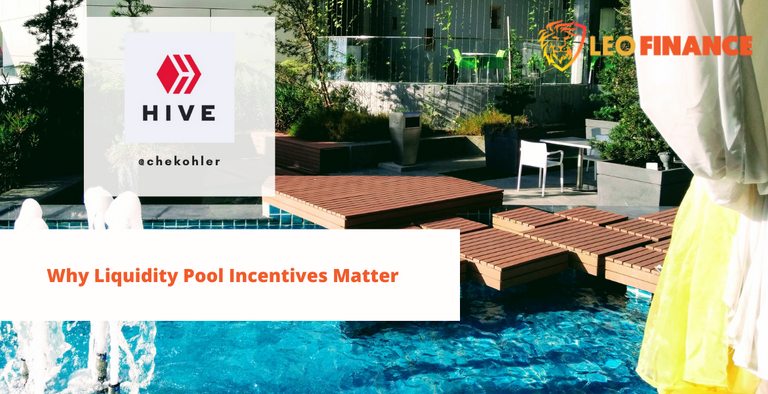Why Liquidity Pool Incentives Matter
Hey Jessinvestors
If you got into crypto in late 2020, then the DE-FI buzzword is surly ringing in your ears, and you’re probably sick and tired of it.
The term is a bit of a misnomer and a catch-all phrase for taking legacy financial products and putting a token somewhere in the mix, and hey, that’s De-Fi in a nutshell. We can all go home now.
We can talk about the various types of De-Fi from staking, flash loans and collateral providers. Still, I want to focus on the one that seems to be the most popular, and that is liquidity providing for decentralised exchanges (DEX’s).
I think it was first started with Bancor on ETH, but it was really Uniswap that took the idea, run with it and turned it into a more crypto mainstream tool.

Why is LP so popular?
Centralized exchanges have always been a love-hate product in crypto! We need on-ramps into the system and a place with reasonable liquidity to supply the market, and early miners used their liquidity to do that.
Eventually, venture capital came in, started mining operations or purchased a lot of coins and spun up exchanges. While exchanges have improved in recent years, there is still the obvious central point of failure, and the Mt Gox wounds are firmly engrained in early Bitcoiners.
The idea of not your keys, not your Cryptos, continues to this day and from it came the solution of DEX’s. Decentralized exchanges that allow you to trade but still have ownership of your keys.
The issue with early DEX’s was that they didn’t have the liquidity to provide for trading pairs, and the project dragged on through altruism until liquidity pools took over with the help of smart contracts.
Liquidity pools a market solution
Liquidity pools allow traders who have coins but don’t feel like trading them; they can provide them to exchanges to fill orders!
As you supply coins into a big pool, it allows those wanting to trade to make orders without running out of supply.
In exchange for borrowing your coins, liquidity pools provide incentives like fees on trades.
This is a simple explanation for how this works and how each market participant benefits from the system.
As you can probably tell, the more liquidity, the bigger the orders that can go through them each day!
The more orders, the more fees, the more fees, the more providers want to get in and get some of those fees and reduce the gains.
Liquidity pools are still in their infancy, and there are so many options that can be included depending on the goals of that exchange or ecosystem.
Flat Fee pools
I think this would be the basic structure of a liquidity pool incentive would be the flat structure. The fees collected for the day exchanging assets that leverage this pool would be distributed across the various providers depending on their contribution to the pool.
Tiered fee pools
Adding a little game theory to it, you could have a tiered approach where if you maintain a certain percentage of the pool, you get a preferred return. This encourages larger holders to remain in the pool.
Burn pools
A burn pool could take some of the day's fees, and instead of rewarding all of it to the providers, some of it can be burned to reduce inflation of the tokens and squeeze supply.
Multi-asset pools
Liquidity pools are often set in a pair, so you would provide an equal amount in, let's say, US dollar value on each side of the trade.
In a multi-asset pool, you could add 1 or several assets to the pool; this works great for stable coins and is something that curve has been using.
For example, you could have HDB, SBD, USDT, DAI and USDC all in one pool.
Hybrid pools
Hybrid pools could grab a mix of different structures, like having a burn component and a tiered fee pool.
These are just a few of the ideas I've seen pitched, and I am sure there will be more coming soon. I think liquidity pools are going to become a greater part of crypto's next steps into adoption.
Have your say
What do you good people of HIVE think?
So have at it, my Jessies! If you don't have something to comment, "I am a Jessie."
Let's connect
If you liked this post, sprinkle it with an upvote or esteem, and if you don't already, consider following me @chekohler and subscribe to my fanbase
| Safely Store Your Crypto | Deposit $100 & Earn $10 | Earn Interest On Crypto |
|---|---|---|
 |  |  |
Posted Using LeoFinance Beta

ZERION Airdroping 400 HIVE
HIVE Staking Will Be Live Soon
Join zerion for early access and 400 HIVE Airdrop
HIve also enters to Defi one step into the future
For More Details and Airdrop click here
phishing scam.
BURN EM!!!!
!ENGAGE 20
ENGAGEtokens.Great, educational post! A lot of great info about pools and how they work or can work... I was just chatting with my friend yesterday about the advantages that these decentralized pools can bring to some coin... The perfect example is LEO, where the ability to trade with it on Uniswap with ETH, creates a lot of possibilities for arbitrage trading, which again, pumps volume on both exchanges (Uni and LeoDex)... and we all know what means the bigger volume in the eyes of potential investors...
But, it's not just that, incentivizing them gives additional profit to liquidity providers as you said... And someone asked me what's the point of diesel pools if there is no fee? Well, again, I think that not only token CREATORS should create these pools to bring attention to the project, but also big stakeholders can do it... If you are a whale, you want that your investment wins, so, why not do something about that...
I know that it sounds weird, especially when we have people that are big stakeholders in Hive (for example) and they don't want to see higher valued HIVE as it will bring other big fish and "take" their "power"...
So, which point of view sounds crazier? Whales fighting to bring additional value, or killing the project to be a big fish in a small pond? :)
Sorry about the long comment :) :)
Posted Using LeoFinance Beta
Oh no these are my favourite kinds of comments, why I think LP's are the future of the industry is because its taking coins off their native chains and they becoming cross asset value. So instead of Leo sitting on HIVE or Ether stuck on ETH they can all jump between chains to be used in other dapps or services, without the need to exchange to native assets.
LP pools means you don' HAVE to have a token for your dapp you can simply accept ETH now even if you are a tool built on EOS for example, that to me unlocks value, makes it easier to use and will kill a lot of coins in the process but that's all part of the market developing.
In future I hope to be able to be BTC only and if I want to use a product I don't want to be forced to buy EOS I want to use my BTC on EOS, or lets say USDT on any chain that's going to make things so much more interesting, now that assets can move around more freely
I am still learning a lot of this pool and stuff. At the moment I still considered it as a normal exchange only. : )
Posted Using LeoFinance Beta
I hope that DEX's will be seen as the normal exchange the more dex's seem normal the more decentralised we can become
Well explained post...
How much time it will take to get the token out from pool?
Posted Using LeoFinance Beta
I think that depends on what you want from the pool and the fees it generates, all of them are going to have different APR's depending on the trading pair and the size of purchases which you need to review before jumping into a pool